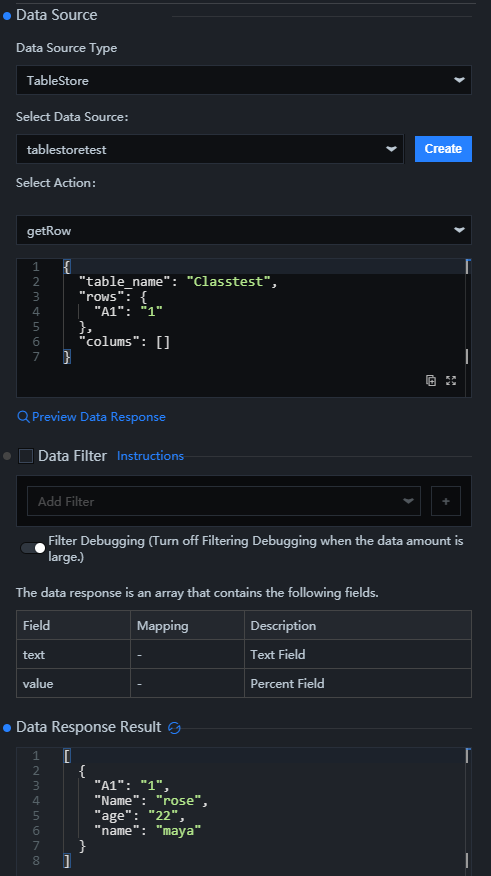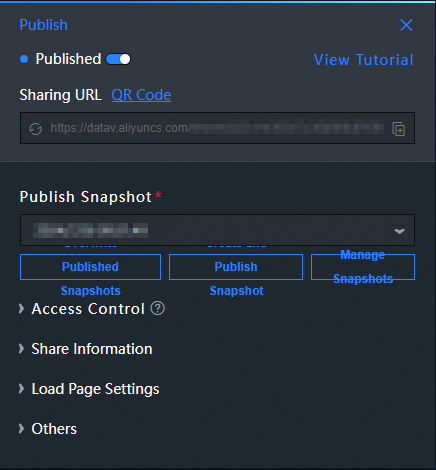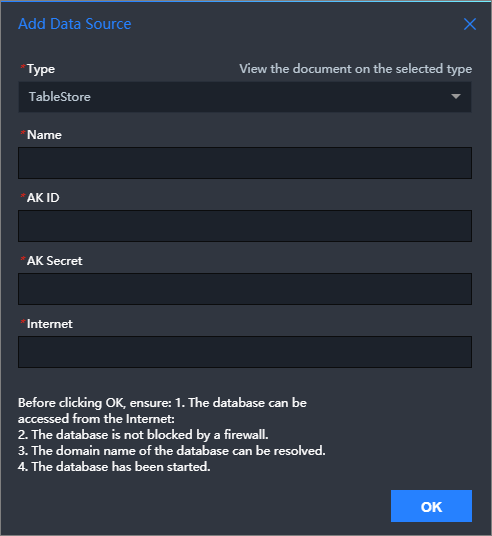After you add a Tablestore data source in the DataV console, you can use DataV to display Tablestore data.
Prerequisites
The following operations are performed in the Resource Access Management (RAM) console:
A RAM user is created and the AliyunOTSFullAccess and AliyunDataVFullAccess policies are attached to the RAM user. For more information, see Create a RAM user and Grant permissions to a RAM user.
WarningIf the AccessKey pair of your Alibaba Cloud account is leaked, your resources are exposed to potential risks. We recommend that you use the AccessKey pair of a RAM user to perform operations. This prevents the AccessKey pair of your Alibaba Cloud account from being leaked.
An AccessKey pair is created for the RAM user. For more information, see Create an AccessKey.
The following operations are performed in the Tablestore console:
Tablestore is activated and an instance is created. For more information, see Activate Tablestore and create an instance.
A data table is created. For more information, see Operations on a data table.
The following operation is performed in the DataV console:
DataV is activated. For more information, see Activate DataV.
Background information
DataV can convert statistical data to a variety of dynamic visual charts. For more information, see What is DataV? After you add a Tablestore data source to DataV, DataV displays real-time data on a dashboard based on the data of Tablestore tables.
Usage notes
Only the Wide Column model of Tablestore is supported. For more information, see Wide Column model.
Tablestore data sources support only data tables and secondary indexes.
Step 1: Add a Tablestore data source
Log on to the DataV console.
Then, configure other parameters for a Tablestore data source. The following table describes the parameters.
Parameter
Description
Name
The display name of the data source.
AK ID
The AccessKey ID of your Alibaba Cloud account or a RAM user that has permissions to access Tablestore.
AK Secret
The AccessKey secret of your Alibaba Cloud account or a RAM user that has permissions to access Tablestore.
Internet
The endpoint of the Tablestore instance that you want to access. For more information, see Endpoints.
Click OK.
The data source that you added is displayed in the data source list.
Step 2: Configure the Tablestore data source
Log on to the DataV console.
On the Projects tab, create a visualization project or select an existing visualization project based on your business requirements.
If you use an existing visualization project, move the pointer over the visualization project and click Edit.

If you use DataV for the first time or the existing visualization projects do not meet your requirements, you can create visualization projects based on your business requirements.
NoteYou can create visualization projects on a PC or mobile device, or by using image recognition. The following example shows how to create a visualization project on a PC.
Click PC Creation.
On the page that appears, move the pointer over the template based on which you want to create a project and click Create Project.
DataV allows you to create a visualization project by using a template or a blank canvas. You can select a method to create a visualization project based on your business requirements.
In the Create Project dialog box, configure the Project Name and Project Group parameters and click Create.

Configure the Tablestore data source.
On the canvas editing page, click a widget on the canvas.
NoteIf no widget exists on the canvas, add a widget first. For more information, see Add a widget.
In the right-side widget configurations panel of the canvas, click the
 icon.
icon. On the Data tab, click Configure Data Source.

In the panel that appears, select TableStore from the Data Source Type drop-down list.
In the Select an existing data source drop-down list, select the configured Tablestore data source.
In the Select Action drop-down list, select the operation that you want to perform.
The following operations are supported:
In the code editor of the Select Action section, enter a query statement.
getRowThe values of query parameters must be JSON objects.
If you select
getRow, a row whose primary key is specified is read.The following sample code and table describe the request syntax and the parameters that you can configure for a query statement.
{ "table_name": "test", "rows": { "id": 1, "pk": "1", }, "columns": [ "id", "pk", "test" ] }Parameter
Description
table_name
The name of the table whose data you want to read.
rows
The primary key information about the row.
ImportantYou must specify the same number and data types of primary key columns as the number and data types of primary key columns in the table.
columns
The names of the columns whose data you want to read.
getRangeThe values of query parameters must be JSON objects.
If you select
getRange, all data whose primary key values are within the specified range is read. The following sample code and table describe the request syntax and the parameters that you can configure for a query statement.{ "table_name": "test", "direction": "FORWARD", "columns": [ "id", "test" ], "range": { "limit": 4, "start": { "id": "InfMin" }, "end": { "id": "3" } } }Parameter
Description
table_nameThe name of the table whose data you want to read.
directionThe order in which you want to sort the rows in the response.
If you set this parameter to FORWARD, the start primary key value must be smaller than the end primary key value, and the rows in the response are sorted in ascending order of primary key values.
If you set this parameter to BACKWARD, the start primary key value must be greater than the end primary key value, and the rows in the response are sorted in descending order of primary key values.
For example, you want to read data in a table and you use A and B as the start and end primary keys of the range to read. The value of A is smaller than the value of B. If you set the direction parameter to FORWARD, the rows whose primary key values are greater than or equal to the value of A but smaller than the value of B are returned in ascending order. If you set the direction parameter to BACKWARD, the rows whose primary key values are smaller than or equal to the value of B but greater than the value of A are returned in descending order.
columnsThe columns whose data you want to read. You can specify the names of primary key columns or attribute columns.
If you do not specify a column, all data of rows is returned.
If the primary key of a row is in the specified range but the row does not contain data of the specified columns, the row is not returned.
limitThe maximum number of rows that can be returned. The value of this parameter must be greater than 0.
An operation stops after the maximum number of rows that can be returned in ascending or descending order is reached, even if some rows in the specified range are not returned.
startThe start and end primary keys of the range to read. The start and end primary keys must be valid primary keys or virtual points that consist of data of the InfMin and InfMax types. The number of columns for each virtual point must be the same as the number of columns of each primary key.
A value of the InfMin type is an infinitely small value. All values of other types are greater than the value of the InfMin type. A value of the InfMax type is an infinitely great value. All values of other types are smaller than the value of the InfMax type.
ImportantYou must specify the same number and data types of primary key columns as the number and data types of primary key columns in the table.
start indicates the start primary key. Rows that contain the start primary key are returned.
end indicates the end primary key. Rows that contain the end primary key are not returned.
end
SQLUse custom SQL statements to query data.
Click Preview Responses of Data Source to view the response.
Preview and publish the project.
In the upper-right corner of the canvas editor, click the
 icon to preview the project.
icon to preview the project. In the upper-right corner of the canvas editor, click the
 icon to publish the project.
icon to publish the project. In the Publish dialog box, click Publish Project.
Close the Published message.
NoteAfter the project is published, the content on the publish page is locked. After you edit the content, you can synchronize the published content by using the snapshot management feature. You can also click Manage Snapshots to view information about snapshots that are created.
Click the
 icon next to the URL in the Sharing URL section to copy the URL.
icon next to the URL in the Sharing URL section to copy the URL. 
Paste the URL to the address bar of a browser to view the published project.
Billing
Tablestore
You are charged based on the pay-as-you-go billing method when you use Tablestore resources. This billing method indicates that you are charged for the Tablestore resources that you used on an hourly basis. For more information, see Billing overview.
DataV
You are charged based on the subscription billing method when you use DataV resources. You can purchase DataV for a minimum of one month. You can select the edition and duration based on your business requirements. For more information, see Billing method.
FAQ
References
You can connect Tablestore to Grafana to display Tablestore data. You can use Grafana to display time series table data of the TimeSeries model. For more information, see Connect Tablestore to Grafana.
